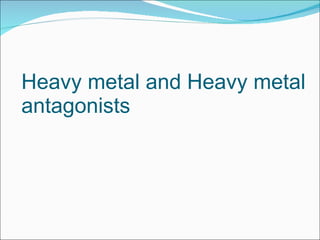
Heavy metal and heavy metal antagonists
- 1. Heavy metal and Heavy metal antagonists
- 2. Heavy metals of concern are Lead Mercury Arsenic Cadmium Exert there toxic effects by combining with one or more reactive groups (Ligands) essential for normal physiological functions. Heavy metals may react in the body with- Ligands containing Oxygen- -OH, -COO - Ligand containing Sulfur- -SH Ligand containing Nitrogen- -NH 2
- 3. Heavy metal antagonists (Chelating agents) are designed specifically to compete with these groups for the metals and prevent or reverse toxic effects and enhance the excretion of metals. Chelate - complex formed b/w a metal and a compound that contains two or more potential ligands. The stability of chelate varies with the metal and the ligand atoms. e.g- lead and mercury have greater affinities for sulfur and nitrogen than for oxygen.
- 6. LEAD Primary source- leaded paints and drinking water environmental & industrial exposure Absorption, distribution and excretion Absorption – g.i.t & the respiratory system g.i.t absorption varies with age- Adults absorb upto 10% of ingested lead Children absorb upto 40% of ingested lead Iron deficiency also enhance intestinal absorption of lead.
- 7. Distribution Once lead is absorbed , about 99% of that in the blood stream binds to hemoglobin in erythrocytes. initial distribution – in the soft tissues particularly tubular epithelium of kidney and in the liver In time- redistributed and deposited in bone, teeth & hair. Excretion- urinary excretion Because most of the lead is in the erythrocytes, very little is Filtered lead is also excreted in milk & sweat. Placental transfer of lead is also known.
- 9. Acute hemolytic crisis sometimes occurs & cause severe anemia & hemoglobinuria. The kidneys are damaged & urinary changes are evident death may Occur in 1-2 days. CHRONIC LEAD POISONING Signs and symptoms may be divided into six categories 1. Gastrointestinal - Anorexia Muscle discomfort headache Constipation usually is an early sign
- 10. 2 . Neuromuscular – muscle weakness easy fatigue occur long before actual paralysis 3. CNS- lead encephalopathy Most serious menifestation specially in children than in adults Early signs- vertigo, insomnia, restlessness, headache, irritability As encephalopathy develops- - patient may first become excited & confused -delirium with repetitive tonic-clonic convulsions & coma follows. -vomiting a common sign -visual disturbances
- 12. Succinyl CoA + Glycine δ-aminolevulinate synthase δ-aminolevulinate (δ-ALA) δ-aminolevulinate dehydratase Porphobilinogen Uroporphobilinogen Coproporphyrinogen Protoporphyrin ferrochelatase +Fe 2+ Heme
- 13. Diagnosis of lead poisoning -Children – lead in blood > 10µg/dl are at risk of Developmental disabilities -Adults- concentration >30µg/dl functional injury or Symptoms -Decrease in δ-aminolevulinate dehydratase activity - Increase in urinary excretion of δ-ALA & increase in Erythrocyte protoporphyrin Patients with lead concentration 30-75µg/dl have all the Above laboratory abnormality
- 16. 1) CaNa 2 EDTA - initiated at a dose of 30-50mg/kg per day divided in two doses,either by deep i.m injection or slow i.v infusion for 5 consecutive days The first dose of CaNa 2 EDTA should be delayed until 4 hrs after the first dose of dimercaprol. An additional course may be given after an interruption of 2 days Each course of therapy should not exceed a total dose of 500mg/kg 2) Dimercaprol - 4mg/kg i.m route every 4 hrs for 48 hrs, then every every 6hrs for 48 hrs finally every 6-12 hrs for additional 7 days.
- 19. Mechanism of action- It readly forms covalent bond with sulfur, & it is this property that accounts for most of the biological properties of the metal. Also combines with phosphoryl, carboxyl, amide and amine group.
- 21. Concentration in urine- normal 5µg/liter TREATMENT Inorganic mercury - maintenance of fluid & electrolyte balance -emesis can be induced if patient is awake & alert chelation therapy Dimercaprol - 5mg/kg i.m initially,followed by 2.5mg/kg i.m every 12-24 hrs for 10 days. OR Penicillamine – 250mg orally every 6 hours
- 23. ARSENIC - Found in soil, water and air as a common environmental Toxicant -Major source of occupational exposure to arsenic –containing Compounds is from manufacture of arsenical herbicides & pesticides. Mechanism of action Arsenate (pentavalent) is a well known uncoupler of mitochondrial oxidative phosphorylation. There is competitive substitution of arsenate for inorganic Phosphate in the formation of adenosine triphosphate
- 24. Subsequent formation of an unstable arsenate ester that is rapidly hydrolysed (Arsenolysis). Toxicological effects of arsenic CVS- Acute & subacute doses induces mild vasodilation this leads to an edema, particularly facial. -hypotention -congestive heart failure -cardiac arrythmias GIT - -mild abdominal cramping -diarrhoea -severe gastroentritis associated with shock.
- 26. Kidneys Severe renal damage Skin Hyperpigmentation in raindrop pattern Nervous system Encephalopathy Neurological lesions Liver- necrosis Carcinogenesis- skin tumors
- 28. -nausea -vomiting -salivation -abdominal cramps Symptoms that appear in a few hours - irritation of respiratory tract with severe,early pneumonitis -chest pain -dizziness
- 29. Chronic cadmium poisoning Kidney - proximal tubular injury proteinuria Lung - dyspnea Bone- osteomalacia Testis - testicular necrosis Treatment of cadmium poisoning - remove the patient from source -respiratory support